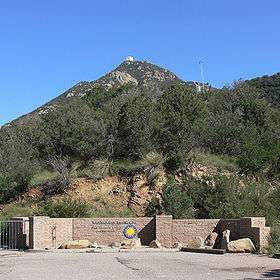Mount Hopkins (Arizona)
| Mount Hopkins | |
|---|---|
 Summit of Mount Hopkins from the entrance to the Fred Lawrence Whipple Observatory that has two locations, one at the bottom of the mountains and the second (this one) located on the slopes of Mount Hopkins. | |
| Highest point | |
| Elevation | 8,553 ft (2,607 m) NAVD 88[1] |
| Prominence | 1,430 ft (436 m) [1] |
| Coordinates | 31°41′18″N 110°53′07″W / 31.6884218°N 110.8853648°WCoordinates: 31°41′18″N 110°53′07″W / 31.6884218°N 110.8853648°W [2] |
| Geography | |
 Mount Hopkins
| |
| Location | Santa Cruz County, Arizona, U.S. |
| Parent range | Santa Rita Mountains |
| Topo map | USGS Mount Hopkins |
Mount Hopkins is a 8,553 feet (2,607 m) peak of the Santa Rita Mountains range, in Santa Cruz County, southern Arizona.
The peak was named after Gilbert Hopkins, who was killed nearby during the Battle of Fort Buchanan in 1865.
It is in the Coronado National Forest and is bounded on three sides by the Mount Wrightson Wilderness.
Fred Lawrence Whipple Observatory
The Fred Lawrence Whipple Observatory is located on the mountain. The prime mover for the mountain's observatory was Fred Whipple, a professor at Harvard University who was in charge of a small 25 inch mirror telescope in Cambridge, Massachusetts. In Cambridge the ambient light caused light pollution that limited the telescope's usefulness.
That led to engineer Tom Hoffman being appointed by Whipple to search for a site in the U.S. that would provide a clear view of the sky at a high elevation, with minimal surrounding light pollution. After searching many locations, southern Arizona with its dry air and high elevations, and the assistance of The University of Arizona, brought Hoffman to focus on Mt Hopkins. Whipple agreed, leaving the challenge of how to transport an 8 metres (26 ft) diameter glass mirror and build a telescope on an 8,583-foot (2,616 m) mountain that had no road.
References
- 1 2 "Mount Hopkins, Arizona". Peakbagger.com. Retrieved 2014-02-07.
- ↑ "Mount Hopkins". Geographic Names Information System. United States Geological Survey. Retrieved 2014-02-07.
External links
| Wikimedia Commons has media related to Fred Lawrence Whipple Observatory. |